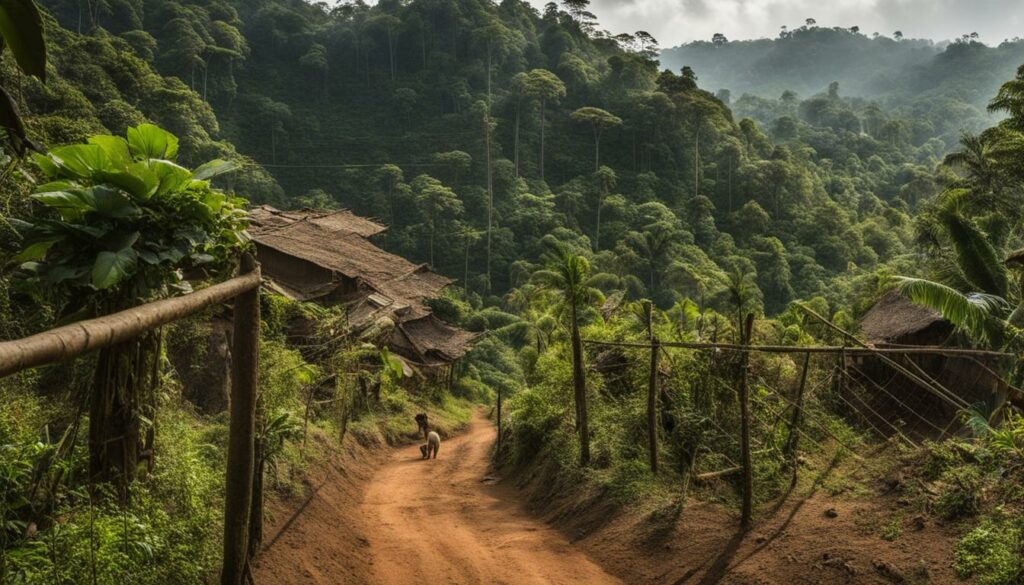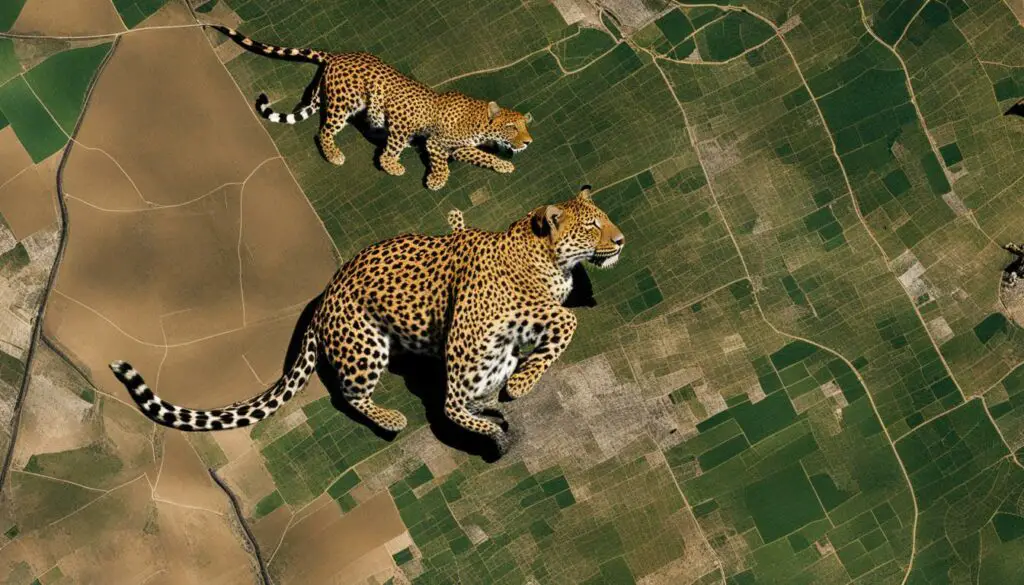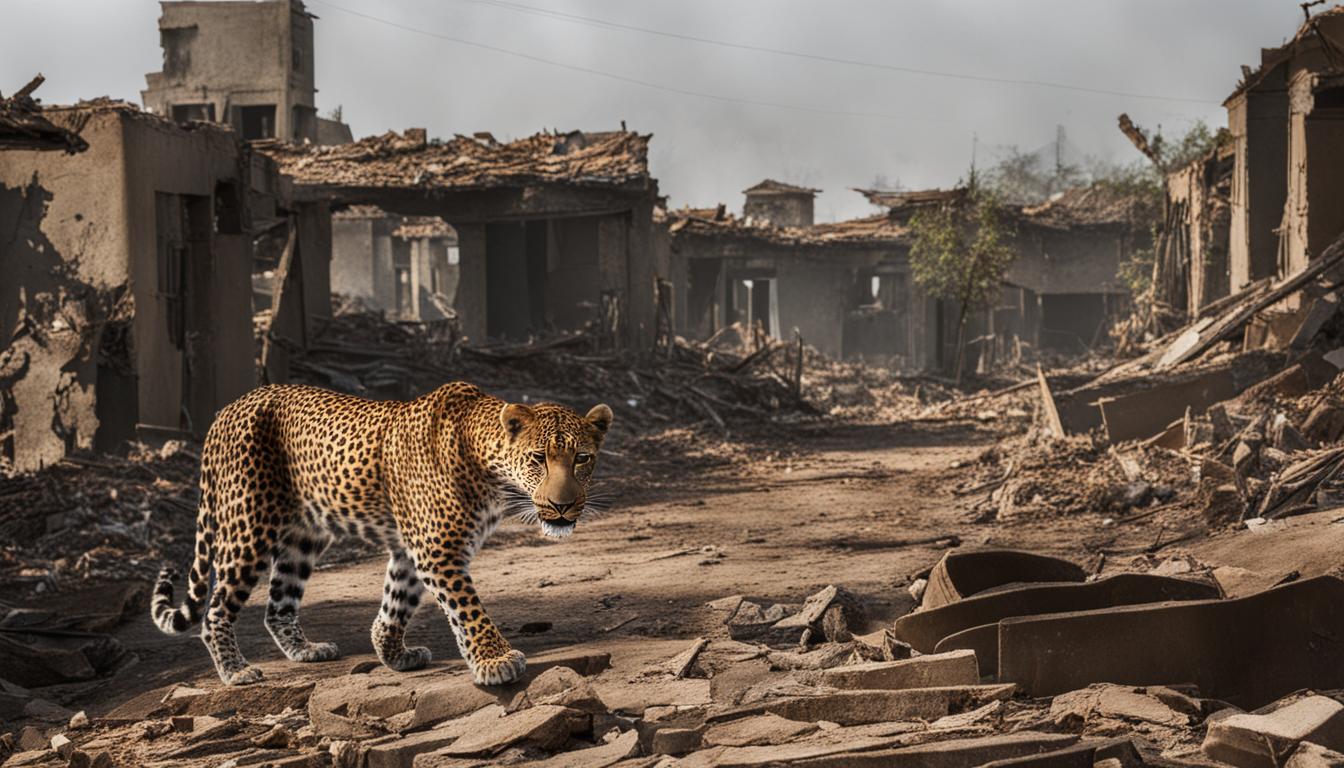Human-leopard conflicts have a significant impact on leopard populations worldwide. Rapid loss of forest cover and human encroachment into leopard habitats has forced these apex predators to inhabit multi-use landscapes outside of protected areas. This has led to an increase in conflicts between leopards and humans, particularly in areas where livestock depredation occurs. These conflicts pose a threat to leopard populations and their long-term survival.
Understanding the Causes of Human-Leopard Conflicts
Human-leopard conflicts arise due to a combination of anthropogenic impacts and natural factors. The primary cause of these conflicts is habitat loss, driven by activities such as deforestation and land use changes. As human populations expand and encroach into leopard habitats, the boundaries between humans and leopards blur, leading to increased encounters and conflicts.
Livestock depredation is another major cause of human-leopard conflicts. Leopards, in their search for prey, often target livestock as an easy source of food. This results in economic losses for local communities and escalates the conflict as humans seek to protect their livelihoods.
To address these conflicts, it is essential to understand the underlying causes and develop strategies that balance the needs of both humans and leopards. This involves finding ways to minimize habitat loss, promote sustainable land use practices, and implement effective livestock management techniques. By addressing the root causes of human-leopard conflicts, we can pave the way for long-term coexistence and conservation efforts.
The Causes of Human-Leopard Conflicts
| Cause | Description |
|---|---|
| Habitat Loss | Rapid deforestation and land use changes have resulted in the loss and fragmentation of leopard habitats, forcing leopards to search for new territories, often overlapping with human settlements. |
| Livestock Depredation | Leopards view livestock as easy prey, leading to conflicts with humans who depend on their livestock for their livelihoods. Retaliation against leopards for livestock losses further exacerbates the conflicts. |
Understanding the causes of human-leopard conflicts is crucial for developing effective mitigation strategies that protect both leopard populations and human communities. By addressing habitat loss, promoting coexistence, and implementing measures to reduce livestock depredation, we can foster a harmonious relationship between humans and leopards in shared landscapes.
Impacts of human-leopard conflicts on leopard populations
Human-leopard conflicts have detrimental effects on leopard populations. The direct killing of leopards in retaliation for attacks on livestock reduces their population size. Additionally, the cascading effects of conflicts, such as changes in behavior and distribution patterns, can disrupt ecological processes and lead to further population declines. Conservation efforts aimed at mitigating conflicts are crucial for the long-term survival of leopard populations.
Impacts on Leopard Populations
When conflicts arise between humans and leopards, the direct killing of leopards is a significant threat to their population. As leopards are targeted due to livestock depredation incidents, their numbers decrease, putting their long-term survival at risk. This loss of individuals has a direct impact on the population size and genetic diversity of leopards.
Furthermore, the consequences of conflicts extend beyond direct killings. The behavioral changes induced by conflicts can alter the dynamics of leopard populations. Leopards may avoid certain areas or alter their hunting patterns, leading to shifts in their distribution and abundance. These changes can disrupt ecological processes and have far-reaching implications for the overall functioning of ecosystems.
Conservation and Mitigation Efforts
To ensure the conservation of leopard populations and minimize the impacts of conflicts, various strategies are implemented. Conservation organizations and wildlife authorities work together to raise awareness about the importance of leopards and the need for their protection. Efforts are made to engage local communities in understanding the ecological role of leopards and the potential benefits of coexistence.
Conservationists also collaborate with livestock owners to develop and implement strategies to reduce depredation incidents. This may involve the use of deterrent measures, such as reinforced enclosures or guard animals, to protect livestock and minimize conflicts. By addressing the underlying causes of conflicts and promoting sustainable practices, conservation efforts can help mitigate the impacts on leopard populations and foster long-term coexistence between humans and leopards.

Mitigating leopard-human conflicts
Mitigating conflicts between leopards and humans requires a comprehensive approach that focuses on conflict resolution and promoting coexistence. By implementing strategies aimed at reducing conflicts and finding sustainable solutions, we can help protect both leopards and human interests.
Conflict resolution strategies
One key aspect of mitigating leopard-human conflicts is conflict resolution. Increasing awareness about high-risk areas and implementing supervised grazing practices can help reduce the vulnerability of livestock and minimize potential conflicts. Additionally, removing vegetation cover around human settlements can discourage leopards from venturing too close, reducing the likelihood of predation on livestock.
“Creating awareness among local communities about the importance of coexistence and providing them with practical solutions is crucial for mitigating conflicts.”
Engaging local communities and stakeholders in conflict resolution efforts is essential. By involving them in decision-making processes and providing education on effective mitigation strategies, we can foster a sense of ownership and responsibility towards coexistence with leopards. This can lead to increased tolerance and understanding, reducing the potential for conflicts to escalate.
The importance of coexistence
Promoting coexistence between leopards and humans is vital for the long-term conservation of leopard populations. This involves finding ways for both leopards and humans to share and utilize landscapes sustainably. Implementing sustainable land-use practices, such as wildlife corridors and habitat restoration, can help enhance connectivity and reduce conflicts by providing leopards with suitable habitats and prey resources.
- Increasing the availability of alternative livelihood options for communities living in leopard habitats can also contribute to coexistence. By diversifying income sources and reducing dependency on livestock, communities can become less vulnerable to leopard predation and less likely to resort to retaliatory actions.
- Developing and implementing comprehensive conservation plans that take into account the needs and perspectives of local communities is crucial. These plans should integrate scientific research, community engagement, and policy interventions to create a framework for sustainable coexistence and conflict mitigation.
By adopting a multi-dimensional approach that combines conflict resolution, coexistence promotion, and sustainable land-use practices, we can work towards a future where leopards and humans thrive together in shared landscapes.
| Conflict Mitigation Strategies | Benefits |
|---|---|
| Increasing awareness about high-risk areas | Reduced vulnerability of livestock and minimized conflicts |
| Implementing supervised grazing practices | Improved livestock management and reduced predation incidents |
| Removing vegetation cover around human settlements | Discouraged leopard presence near human habitats |
| Engaging local communities in conflict resolution | Increased tolerance and understanding towards leopards |
| Implementing sustainable land-use practices | Enhanced habitat connectivity and reduced conflicts |
| Creating alternative livelihood options | Reduced dependency on livestock and increased community resilience |
Mapping Conflict Hotspots and Risk Zones
Spatial risk mapping is a valuable tool for identifying conflict hotspots and risk zones where human-leopard conflicts are more likely to occur. By analyzing landscape features and their relationship to past conflict incidents, wildlife managers and conservationists can prioritize interventions and allocate resources effectively. Understanding the spatial distribution of conflicts allows for targeted measures to be implemented, reducing conflicts and protecting both humans and leopards.

Identifying high-risk areas through spatial risk mapping provides critical insights into the factors that contribute to human-leopard conflicts. This data-driven approach allows for evidence-based decision-making and the implementation of proactive measures to mitigate conflicts. By focusing efforts on high-risk areas, conservationists can address the root causes of conflicts and work towards long-term solutions for both leopard populations and human communities.
Factors Considered in Spatial Risk Mapping
When mapping conflict hotspots and risk zones, several factors are taken into consideration. These may include:
- Proximity of human settlements to leopard habitats
- Availability of suitable prey for leopards in the area
- Presence of livestock in close proximity to leopard territories
- Historical conflict incidents and patterns
- Land use practices and landscape fragmentation
By analyzing these factors and their spatial relationships, researchers can identify areas where conflict potential is high and implement targeted strategies to reduce conflicts.
| Conflict Hotspot | Risk Level | Key Contributing Factors |
|---|---|---|
| Area A | High | Significant human encroachment, high livestock density, historical conflict incidents |
| Area B | Moderate | Moderate human encroachment, moderate livestock density, recent conflict incidents |
| Area C | Low | Minimal human encroachment, low livestock density, no recent conflict incidents |
“Spatial risk mapping allows us to prioritize our efforts in mitigating human-leopard conflicts. By focusing on conflict hotspots and high-risk areas, we can implement interventions that address the underlying causes of conflicts and promote coexistence between leopards and humans.”
Overall, spatial risk mapping provides valuable insights into the spatial distribution of human-leopard conflicts. By identifying conflict hotspots and high-risk areas, researchers and conservationists can develop targeted strategies for conflict mitigation and promote the long-term coexistence of leopards and humans in shared landscapes.
Understanding the Ecological and Socio-Economic Implications of Conflicts
Human-leopard conflicts have profound ecological and socio-economic implications. The loss of large carnivores like leopards can disrupt ecosystem functioning and lead to changes in predator-prey dynamics. Without the presence of leopards, herbivore populations may increase, resulting in overgrazing and habitat degradation. This can have a cascading effect on the entire ecosystem, impacting plant diversity and overall ecosystem health. Additionally, leopards play a vital role in regulating prey populations, contributing to the stability and balance of the ecosystem.
Furthermore, the socio-economic impacts of conflicts are significant. Retaliation by local communities against leopards can hinder conservation efforts and strain relationships between humans and wildlife. This can create a negative perception of leopards among communities, leading to increased hostility towards them. In turn, this may lead to further conflicts and challenges in implementing effective conservation measures. It is crucial to address the socio-economic aspects of conflicts to ensure the well-being of both humans and leopards.
“The loss of large carnivores like leopards can disrupt ecosystem functioning and lead to changes in predator-prey dynamics.”
Moreover, conflicts have direct implications for human welfare, particularly in rural areas where livestock represents a valuable asset. The economic costs of livestock losses can have far-reaching consequences for local communities, impacting their livelihoods and socio-economic stability. Finding sustainable solutions that address both the needs of the communities and the conservation of leopards is crucial to ensure the well-being of humans and the long-term survival of leopard populations.
Efforts to mitigate human-leopard conflicts should take into account the ecological implications, socio-economic impacts, and the welfare of both humans and leopards. By understanding the complexities of these conflicts and working towards a collaborative and multi-faceted approach, we can strive towards long-term coexistence and the preservation of leopard populations.
Strategies for Long-Term Coexistence
When it comes to achieving long-term coexistence between leopards and humans, a comprehensive approach is essential. This involves engaging various stakeholders, implementing community-based conservation initiatives, and promoting sustainable land use practices.
Stakeholder engagement plays a crucial role in leopard conservation and conflict mitigation efforts. By involving local communities, policymakers, and conservation organizations, a collaborative approach can be fostered, ensuring that the perspectives and concerns of all parties are taken into account. This collaborative approach allows for the development and implementation of effective strategies that address both the conservation needs of leopards and the socio-economic needs of human communities.
Community-Based Conservation Initiatives
Community-based conservation initiatives are another key aspect of promoting long-term coexistence. These initiatives involve empowering local communities with the knowledge and tools to actively participate in leopard conservation efforts. By involving communities in decision-making processes and providing them with incentives for conservation, such as sustainable livelihood opportunities, the conservation of leopards can be integrated into the fabric of local societies.
Sustainable Land Use Practices
Sustainable land use practices are crucial for creating habitats that support both leopards and humans. This includes implementing measures to reduce habitat fragmentation, protecting wildlife corridors, and promoting sustainable agriculture and livestock management practices. By ensuring that human activities are compatible with leopard conservation, the negative impacts of human-leopard conflicts can be minimized.
By adopting these strategies for long-term coexistence, we can protect leopard populations while also safeguarding the well-being of human communities. Through collaboration, community engagement, and sustainable practices, we can create a future where leopards and humans thrive together in shared landscapes.
Conclusion
Leopard-human conflicts have a significant impact on leopard populations and present challenges to their conservation. However, by understanding the causes and impacts of these conflicts, and implementing strategies for conflict resolution and coexistence, we can pave the way for mitigating these conflicts and protecting leopard populations.
Efforts in conflict resolution play a crucial role in addressing the challenges posed by leopard-human conflicts. By raising awareness about high-risk areas, implementing supervised grazing practices, and removing vegetation cover around human settlements to reduce predation on livestock, we can reduce the occurrence of conflicts and promote peaceful coexistence between leopards and humans.
Effective leopard conservation requires collaboration and engagement between various stakeholders, including local communities, policymakers, and conservationists. By working together, we can develop and implement sustainable land use practices, community-based conservation initiatives, and other strategies that facilitate long-term coexistence between leopards and humans.
Through these efforts, we can find sustainable solutions that allow leopards and humans to thrive together, ensuring the continued survival and well-being of both species. By prioritizing conflict resolution and leopard conservation, we can create a future where leopard-human conflicts are minimized, and coexistence between these apex predators and humans is achieved.
What is the Impact of Human-Leopard Conflicts on Wild Leopard Populations?
Human-leopard conflicts have a detrimental impact on leopards in the wild. Encroachment on leopard habitats has led to increased conflicts, resulting in loss of leopard populations. Conservation efforts are crucial in mitigating these conflicts to ensure the survival of leopards in the wild.
Do human-animal conflicts have a similar impact on different big cat populations?
Human-animal conflicts, particularly humancheetah conflicts, have varying impacts on different big cat populations. These conflicts arise due to habitat loss, habitat fragmentation, poaching, and retaliatory killings. While the consequences differ, such conflicts pose significant threats to cheetah populations. Efforts are needed to mitigate conflicts, promote coexistence, and ensure the preservation of diverse big cat populations worldwide.
FAQ
How do human-leopard conflicts impact leopard populations?
Human-leopard conflicts have a significant impact on leopard populations worldwide. The rapid loss of forest cover and human encroachment into leopard habitats force these apex predators to inhabit multi-use landscapes outside of protected areas, leading to increased conflicts and posing a threat to leopard populations.
What are the causes of human-leopard conflicts?
Human-leopard conflicts arise due to rapid habitat loss and fragmentation caused by anthropogenic activities such as deforestation and land use changes. Leopards venture into human-dominated landscapes in search of prey and livestock depredation by leopards is a major cause of conflicts.
What are the impacts of human-leopard conflicts on leopard populations?
Human-leopard conflicts have detrimental effects on leopard populations. Direct killing of leopards in retaliation for attacks on livestock reduces their population size, while the cascading effects of conflicts disrupt ecological processes and lead to further population declines.
How can leopard-human conflicts be mitigated?
Mitigating leopard-human conflicts requires a multi-faceted approach. Conflict resolution strategies include increasing awareness about high-risk areas, implementing supervised grazing practices, and promoting coexistence through community engagement and education.
How can conflict hotspots and risk zones be identified?
Spatial risk mapping is a useful tool for identifying conflict hotspots and risk zones where human-leopard conflicts are more likely to occur. By analyzing landscape features and past conflict incidents, wildlife managers and conservationists can prioritize interventions and allocate resources more effectively.
What are the ecological and socio-economic implications of human-leopard conflicts?
Human-leopard conflicts have profound ecological implications, as the loss of large carnivores can disrupt ecosystem functioning and predator-prey dynamics. Retaliation by local communities against leopards can hinder conservation efforts and strain relationships between humans and wildlife. Additionally, economic costs of livestock losses can impact human welfare, especially in rural areas where livestock represents a valuable asset.
What strategies promote long-term coexistence between leopards and humans?
Achieving long-term coexistence requires stakeholder engagement, community-based conservation initiatives, and sustainable land use practices. Collaboration between government agencies, wildlife managers, conservation organizations, and local communities is crucial in developing and implementing effective strategies for leopard conservation and mitigating conflicts.
What are the key takeaways about human-leopard conflicts?
Human-leopard conflicts have significant impacts on leopard populations and present challenges to their conservation. However, through understanding the causes and impacts of conflicts and implementing strategies for conflict resolution and coexistence, it is possible to mitigate conflicts and protect leopard populations.










